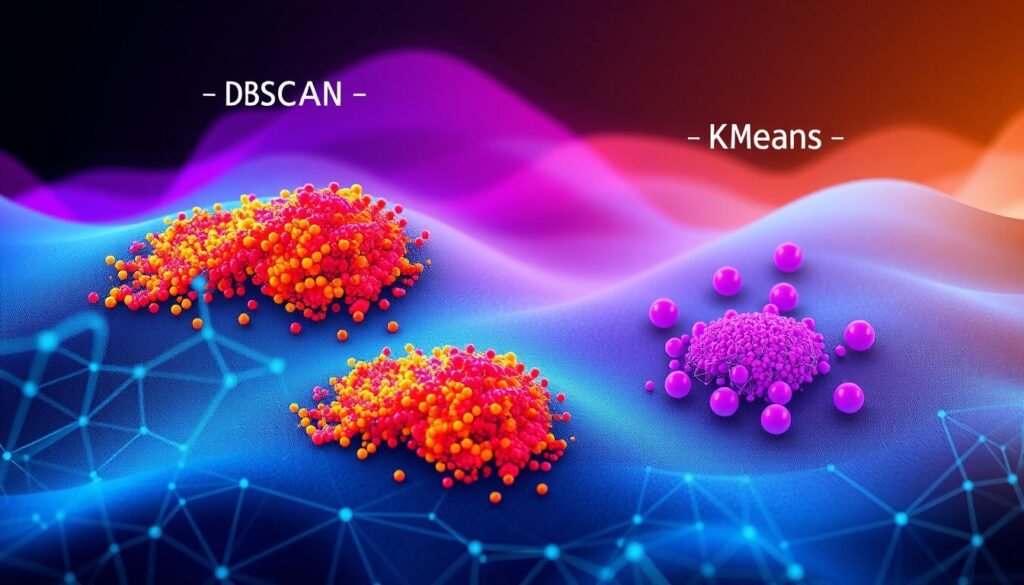DBSCAN vs. K-Means is a crucial comparison for anyone looking to uncover hidden patterns in data through clustering. These two popular algorithms offer distinct approaches, each with unique strengths suited for different types of datasets. This guide is designed to help data analysts and machine learning professionals understand when and how to use each method effectively.
DBSCAN excels at detecting clusters of varying shapes and densities, making it ideal for complex data structures. In contrast, K-Means is known for its speed and efficiency, especially with well-separated, spherical clusters. Knowing these differences enables more informed decisions when selecting a clustering algorithm for your specific goals.
Whether you’re working with large-scale data or smaller datasets, understanding how DBSCAN and K-Means operate can significantly improve your data segmentation strategy.
Key Takeaways
- DBSCAN and K-Means are two main ways to find data patterns.
- The choice between them depends on the dataset’s needs.
- Knowing each algorithm’s strengths and weaknesses is key to picking the right one.
- DBSCAN is great for finding clusters of all shapes and sizes, making it versatile.
- K-Means is simple and fast, best for round clusters.
- Understanding these algorithms helps analysts choose the best method for their data.
An Introduction to Clustering Algorithms
Clustering algorithms are key in machine learning and data science. They group objects so that similar ones are together. This section will cover the basics of clustering and why choosing the right algorithm is important.

Understanding the Basics of Clustering
Clustering basics mean finding groups of similar data points. The k-means algorithm and dbscan algorithm are two main types. K-means divides data into K groups easily. DBSCAN, on the other hand, finds clusters without knowing how many there are.
The Importance of Selecting an Appropriate Clustering Algorithm
Choosing the right algorithm, like DBSCAN or k-means, is key for good data analysis. The dataset’s nature and the project’s scale matter. The right algorithm uncovers complex patterns and offers deep insights in clustering in data science.
A table below shows when to use k-means or DBSCAN:
| Data Type | K-Means | DBSCAN |
|---|---|---|
| Large Datasets | Efficient time complexity | Better at identifying outliers |
| Cluster Shape | Assumes spherical clusters | Handles arbitrary shaped clusters |
| Need for Predefined Clusters | Yes | No |
| Use Case Scenarios | Market segmentation | Anomaly detection |
What is K-Means Clustering?
K-Means clustering is a key algorithm in machine learning. It divides a dataset into a set number of clusters. Each point is assigned to the cluster with the closest mean. This makes it great for quickly finding patterns in large data sets.

Using K-Means helps find natural groupings in data. It’s used in market segmentation, document sorting, and image compression. This shows its wide range of uses and how well it works.
Exploring the K-Means Algorithm
The process starts with picking K initial centroids. Then, it goes through two main steps. First, it assigns each data point to the nearest centroid. Next, it updates the centroid of each cluster.
This cycle keeps going until the centroids no longer change. This leads to groups of similar data points in a mix of different data.
K-Means Algorithm Use Cases
K-Means finds diverse applications across industries—segmenting customers in retail for personalized marketing, grouping behavioral patterns in finance to spot fraud, and organizing medical imaging data in healthcare to streamline analysis.
Understanding K-Means can also help with predictive insights. Just like linear regression models, K-Means is good at spotting patterns in data.
Brief Overview of DBSCAN (Density-Based Spatial Clustering of Applications with Noise)
The DBSCAN clustering explained focuses on finding dense areas in a dataset. It’s great at creating clusters of different shapes and sizes. Density-based clustering like DBSCAN is known for its skill in handling spatial data and its ability to ignore outliers.
Knowing about core points, border points, and noise points is key for DBSCAN implementation. Core points are the heart of a cluster, having a certain number of close points. Border points are not as dense but are connected to a core point. Noise points don’t fit into any category and are ignored.
To get the most out of DBSCAN in Python, you need to understand its settings. Changing ‘epsilon’ (eps) and ‘MinPts’ can greatly change the clusters. Using DBSCAN in Python makes it easy to work with other data science tools.
DBSCAN is a great choice for those looking to group complex data. It’s flexible and works well with real-world data, even when it’s not perfectly organized.
Key Parameters in DBSCAN and K-Means
Understanding the key parameters in clustering algorithms is key to getting the best results. DBSCAN and K-Means have unique parameters that need careful tuning. This tuning is essential for each model’s performance.
DBSCAN Parameters: Epsilon and Min_samples
DBSCAN’s success depends on its two main parameters: epsilon and min_samples. Epsilon sets the radius around each point, helping to find dense clusters. Min_samples is the minimum number of points needed for a dense region. Optimizing DBSCAN parameters like these boosts the algorithm’s cluster discovery in spatial data.
Changing epsilon and min_samples affects how clusters form:
| Epsilon Value | Min_samples Value | Resulting Cluster Formation |
|---|---|---|
| 0.5 | 5 | Denser, smaller clusters |
| 1.0 | 5 | Broader, fewer clusters |
| 0.5 | 10 | Fewer, more distinct clusters |
| 1.0 | 10 | More coverage with less complexity |
K-Means Parameters: Number of Clusters
K-Means focuses on the number of clusters. Picking the right k requires data knowledge and understanding of the clustering’s purpose. The Elbow Method is a way to find the best k for K-Means, making it more useful for real data.
This comparison shows the importance of tuning DBSCAN parameters and K-Means parameters. Effective hyperparameter tuning unlocks DBSCAN and K-Means’ full power, tailored to specific challenges.
Comparative Analysis: DBSCAN vs. K-Means
This analysis compares DBSCAN and K-Means to see which clustering algorithm works better. Clustering algorithm performance is key for data scientists. They use these methods to find groups in data.
The data clustering techniques comparison shows each method’s strengths and weaknesses. DBSCAN can find clusters of any shape and handle outliers well. On the other hand, K-Means is faster but only works with spherical clusters. The choice between these algorithms depends on the data’s structure and diversity.
- DBSCAN vs K-Means:
- DBSCAN is great for complex data with noise.
- K-Means is better in high-dimensional spaces and works fast on big datasets.
Choosing the right clustering algorithm depends on the data’s needs and nature.
| Feature | DBSCAN | K-Means |
|---|---|---|
| Cluster Shape Flexibility | High (any shape) | Low (spherical) |
| Handling of Outliers | Good | Poor |
| Scalability | Medium | High |
| Parameter Sensitivity | High | Low |
Knowing these differences helps make better choices when dealing with clustering challenges or data clustering techniques comparison scenarios.
DBSCAN in Action: A Step-by-Step Guide
Start your journey into DBSCAN clustering with this detailed guide. We’ll cover the key steps for using DBSCAN scikit-learn. You’ll also learn how to visualize your clustering results effectively.
DBSCAN Clustering Steps
The first step is to understand and prepare your data. It’s wise to normalize or standardize your data. This makes DBSCAN’s distance calculations meaningful.
Next, pick the right values for DBSCAN’s main parameters: eps and min_samples. Eps is the radius around a point, and min_samples is how many points must be nearby for a point to be a core point.
After setting these parameters, use DBSCAN scikit-learn to fit the model to your data. This step finds core points, reachable points, and noise points that don’t belong to any cluster.
Visualizing DBSCAN Clustering Results
Visualizing your results is key in DBSCAN clustering. It helps you see patterns in your data. Use libraries like Matplotlib or Seaborn to plot your points and color them by cluster or noise.
Visuals make understanding easier and help you adjust parameters. A scatter plot showing different clusters can really show off DBSCAN’s power.
Follow these steps and use visualization techniques to get deep insights from your data. This guide is perfect for both beginners and experts in data science. It’s a practical way to learn DBSCAN using scikit-learn.
K-Means Clustering: Implementation and Visualization
Learning machine learning means knowing both the theory and how to apply it. K-Means clustering is great for grouping similar data. This guide will show you how to do K-Means clustering in Python with K-Means scikit-learn. It also shares tips on making your clustering visualization better.
Implementing K-Means in Python
To use K-Means well, follow a step-by-step guide. First, prepare your data by making sure all values are the same scale. Then, pick how many clusters (K) you want and start the K-Means algorithm from scikit-learn. You’ll need to set how many times to run the algorithm and how many times to update the cluster centers.
Choosing the right number of clusters is key. Use the “Elbow Method” to find the best K. This method plots the sum of squared distances to the centroid and picks the K where the plot bends. It balances cluster compactness and number.
Visualizing K-Means Clustering Output
Clustering visualization is important for understanding your data. Python’s matplotlib and seaborn are great for this. After running K-Means, plot your data with different colors for each cluster. Mark the centroid of each cluster to show its importance.
For a deeper look, try PCA to reduce data dimensions. This makes your data easier to see on a two-dimensional plot. It helps you see how data points cluster around the centroids.
Advantages and Disadvantages of DBSCAN and K-Means
Choosing the right clustering algorithm is key to good data analysis. DBSCAN and K-Means have their own strengths and weaknesses. This makes them good for different data challenges. Let’s look at when to use each one.
DBSCAN Advantages: Flexibility in Cluster Shapes
DBSCAN is great because it can find clusters of any shape. This is useful in fields like environmental studies or finding anomalies. For more on clustering differences, check out this detailed comparison.
K-Means Advantages: Ease and Speed of Computation
K-Means is simple and fast, making it great for big datasets. It’s quick, but it only works for round clusters. You also have to pick the number of clusters yourself.
DBSCAN Limitations: Sensitivity to Parameters
DBSCAN’s big challenge is its need for careful parameter setting. The right epsilon and min_samples are key. If not set right, DBSCAN might not find good clusters or might find too many outliers.
K-Means Disadvantages: Assumption of Spherical Clusters
K-Means assumes clusters are round and the same size. This can mess up real data. It’s not good for non-round clusters or when cluster sizes vary a lot. When not to use K-Means also includes categorical data.
| Feature | DBSCAN | K-Means |
|---|---|---|
| Cluster Shape | Flexible, any shape | Spherical |
| Handling of Outliers | Robust | Sensitive |
| Parameter Sensitivity | High (Epsilon, Min_samples) | Medium (Number of clusters) |
| Typical Use-case | Anomaly detection, complex pattern recognition | Large dataset segmentation, fast clustering needs |
In summary, DBSCAN and K-Means are good for different things. DBSCAN is great for complex patterns, while K-Means is fast for big datasets. Knowing these helps pick the best method for your data.
Practical Scenarios: When to Use DBSCAN over K-Means?
Choosing the right clustering algorithm is key to data analysis success. This section looks at when to use DBSCAN and K-Means. They are great for tasks like anomaly detection, spatial data clustering, customer segmentation, and marketing analysis.
DBSCAN for Anomaly Detection and Spatial Data Clustering
DBSCAN is top-notch for finding outliers in data. It’s perfect for keeping data clean and catching unusual points. These could be errors, fraud, or security threats.
DBSCAN also works well with spatial data. It can handle different densities and shapes. This is important in geographic data where object relationships matter.
K-Means for Customer Segmentation and Marketing Analysis
K-Means is great for segmenting customers. It groups them by what they buy and who they are. This helps in making marketing more targeted.
K-Means is also good with big data. It’s simple and fast. This makes it perfect for marketing analysis, giving insights for better campaigns.
| Feature | DBSCAN | K-Means |
|---|---|---|
| Best Use Case | Anomaly detection, spatial data clustering | Customer segmentation, marketing analysis |
| Data Shape Suitability | Irregular, varies | Spherical, evenly sized clusters |
| Handling Outliers | Excellent – identifies and isolates outliers | Poor – outliers can skew the mean |
| Scalability | Good with noise, challenging with large datasets | Excellent – efficient with large datasets |
| Pre-defined Clusters | Not required | Number of clusters must be specified |
Choosing between DBSCAN and K-Means depends on your data and project needs. DBSCAN is great for handling anomalies and spatial data. K-Means is better for segmenting large customer data sets. This makes it key for marketing and sales.
DBSCAN vs. K-Means: Machine Learning and Big Data Applications
In the world of big data and machine learning, choosing the right clustering algorithm is key. This section looks at DBSCAN clustering for big data and K-Means machine learning. We see how they work well in different big data settings.
DBSCAN for Big Data and IoT Applications
DBSCAN clustering for big data is great for complex, irregular data clusters. It’s perfect for IoT, where data flows in and is very detailed. DBSCAN is strong in finding patterns and spotting odd data in big IoT networks.
K-Means in Scalable Machine Learning Environments
K-Means machine learning is top for when you need to scale up. It’s simple and fast, making it great for big datasets. K-Means is perfect for tasks that need quick, accurate results.
| Feature | DBSCAN | K-Means |
|---|---|---|
| Data Shape Handling | Handles complex shapes well | Limited to spherical clusters |
| Scalability | Scalable with efficient indexing | Highly scalable, better for very large datasets |
| Application | Suited for anomaly detection and spatial data | Ideal for market segmentation and large-scale clustering |
| Performance | Depends on parameter settings (eps and minPts) | Fast performance, depends on number of clusters |
DBSCAN is flexible and detailed, perfect for complex IoT environments. K-Means is fast and simple, great for big, straightforward clustering tasks.
Conclusion
Choosing the right clustering algorithm is key in data science. It depends on understanding your data and what you want to achieve. We’ve looked at DBSCAN and K-Means, two top clustering methods.
DBSCAN is great for complex, noisy data because it can find clusters of any shape. K-Means is better for data that’s evenly spread and has round clusters. Knowing what your data needs is essential.
This comparison shows how important choosing the right algorithm is. DBSCAN is perfect for finding clusters in dense, noisy data. K-Means works well when clusters are round and data is spread out evenly. While there’s no single best choice, understanding each algorithm’s strengths can help you make the best decision.
Ultimately, picking between DBSCAN and K-Means depends on your project’s needs. We suggest considering each algorithm’s strengths and weaknesses. With careful thought, you can use these algorithms to their fullest in data science. Let your project’s goals and data guide you to the best clustering strategy.
FAQ
What are the main differences between DBSCAN and K-Means?
DBSCAN finds clusters based on density. It looks for high-density areas and separates them with low-density areas. This makes it good for finding clusters of any shape and handling outliers well.
K-Means, on the other hand, groups data into K clusters around a center point. It assumes clusters are round and roughly the same size. This might not work for all data types.
When should I choose DBSCAN over K-Means?
Choose DBSCAN for data with outliers or noise. It’s also better for clusters that aren’t round or the same size. It’s great for spatial data and finding anomalies.
If your data has clusters of different shapes, DBSCAN is a better choice than K-Means.
How do I select the epsilon and min_samples parameters in DBSCAN?
Epsilon is the radius around a point to consider it part of a cluster. Min_samples is the minimum number of points for a dense area. These are key for DBSCAN’s performance.
You can choose these parameters based on your knowledge, or use methods like grid search with clustering metrics.
Can K-Means be used for non-spherical clusters?
K-Means works best with spherical clusters. For non-spherical clusters, try DBSCAN or advanced K-Means versions like kernel K-Means or K-Means++.
What is clustering and why is selecting the right algorithm important?
Clustering groups similar data points together without labels. Choosing the right algorithm is key because different algorithms work better for different data types. The right choice affects the quality of your results.
Are there any limitations to using DBSCAN?
Yes, DBSCAN has some limits. It’s sensitive to epsilon and min_samples parameters. It may struggle with clusters of different densities.
DBSCAN is also more complex than K-Means and can be slow for large datasets. It doesn’t work well when clusters are not clearly separated.
How is K-Means clustering implemented in Python?
In Python, use scikit-learn for K-Means clustering. Create a KMeans instance, set the number of clusters (K), and fit it to your data. The library handles the process of assigning points to clusters and updating centroids.
What is the ‘curse of dimensionality’ and how does it affect DBSCAN?
The ‘curse of dimensionality’ makes data harder to work with as dimensions increase. This affects DBSCAN because it’s based on density. High-dimensional data can make DBSCAN less effective unless you reduce dimensions first.
Can DBSCAN handle big data and IoT applications?
DBSCAN can handle big data and IoT, but it needs optimizations. Techniques like approximate nearest neighbor search help manage memory and speed. Its density-based approach is useful for IoT’s spatial clustering needs.
What metrics are used to evaluate the performance of clustering algorithms?
Use metrics like Silhouette Coefficient, Calinski-Harabasz Index, Davies-Bouldin Index, and Mutual Information scores. These evaluate how well clusters are formed. They look at how well points are grouped within clusters and how they differ from others.






















19 thoughts on “DBSCAN vs. K-Means : Choosing the Best Fit for Your Data”
What’s up every one, here every one is sharing these knowledge, so it’s pleasant to read this webpage, and
I used to go to see this webpage all the time.
Visit my homepage; Company Flags
I always emailed this website posst page to aall my friends, because if like to read it afterward
my friends will too.
my web site … six Flags Fiesta texas
Do you have a spam ssue on this blog; I also am a blogger, and I was curious about your situation; many of
us have developed som nice practices and we are looking to
swap methods with other folks, why not shoot me an e-mail if
interested.
my blog :: Fiesta Texas
I wanted to thank you for this good read!! I absolutely loved every
biit of it. I have got you book-marked to check out new things you post…
Feel free to surf to my web-site Six Flags Discovery kingdom
Thanks on your marvelous posting! I quite enjoyed reading it, you will be a great author.I
will remember to bookmark your blog and will come back sometime soon. I want to
encourage one to continue your great posts, have a nice holiday weekend!
Feel free to visit my blog Dating profile
My brother suggested I might like this website. He used to be
totally right. This post truly made my day. Yoou can not
believe just how a lot time I had sppent for this info!
Thanks!
my blog post :: Online dating
Hello just wanted to give you a quick heads up.
The text in ykur post seem to be running off the screen in Firefox.
I’m not sure if this is a formatting issue or someething to
ddo with web browser compatibility but I figured I’d post to let you know.
The design llook great though! Hope you get the issue solved soon. Thanks
Here is my blog … รับจัดงานศพ
Very good blog! Do you have any recommendations for aspiring writers?
I’m hoping to start my owwn blog soon buut I’m a little lost on everything.
Would you recommend starting with a free platform lile WordPress or go for a paid option?
There are so many choices out there that I’m totally confused ..
Any recommendations? Cheers!
My blog – Boonforal
Spending my cheap car insurance dallas tx plan each year instead of monthly spared me around 5%.
It is actually a chump change, however those cost savings add up
with time.
Woah! I’m really loving the template/theme of
this website. It’s simple, yet effective. A lot of times it’s very difficult to get
that “perfect balance” between user friendliness and visual
appeal. I must say you’ve done a awesome job with this.
In addition, the blog loads super fast for me on Firefox.
Excellent Blog!
Discover Your True Self with Crave Burner Appetite SuppressantWith so many
temptations around, it can be tough to adhere to your diet.
Meet Crave Burner Appetite Suppressant. This groundbreaking product aims to assist you in managing
your cravings and enhance your weight loss efforts.Let’s uncover
the benefits, attributes, and science that underpins this
exceptional appetite suppressor.What is Crave Burner – claude.ai,?Crave Burner is a
research-verified appetite suppressant that
helps you curb those pesky hunger pangs. This
supplement is perfect for individuals navigating the difficulties of
weight loss, as it targets the body’s processes that activate hunger.What Makes It Work?These
ingredients work in harmony to:Balance your hunger-related hormones.Elevate
metabolic activity.Promote the burning of fat.Improve mood and reduce emotional eating.What sets Crave Burner apart?So, why should
you consider Crave Burner over other suppressants for
appetite? Here are a few compelling reasons:Research-verified: Backed by scientific studies, this hunger suppressant ensures effectiveness.Natural Ingredients: Made
from nature’s best, it’s a safe option for long-term use.No Side Effects: Countless users
testify to experiencing minimal or no side effects
alongside other suppressants.The Ingredients Behind the MagicCrafted with effectiveness in mind, Crave Burner includes these powerful natural ingredients:Glucomannan – a fiber that swells in your stomach, aiding in feelings of fullnessGreen Tea Extract – celebrated for its properties that boost metabolismGarcinia Cambogia – a fruit-derived extract
that helps inhibit fat productionHow to Incorporate Crave Burner into Your RoutineAdding Crave Burner to your everyday schedule is a breeze!To experience a quicker feeling of fullness, take the advised dosage before your meals.
Combine this with a nutritious diet and consistent physical activity for the best outcomes.Frequently
Asked Questions (FAQ)1. Can I safely use Crave Burner?Yes,
Crave Burner consists of natural ingredients that are commonly viewed
as safe. Still, consulting a healthcare professional before trying a
new supplement is essential, especially if you have health concerns.2.
When should I anticipate seeing results?Individual results will vary, yet many people mention that they experience fewer cravings within a week of regular use, along with increased
energy levels and enhanced mood.3. Am I able to take Crave Burner alongside other
medications?You should definitely consult your healthcare provider if you’re taking any other medications,
as they can offer personalized guidance considering your unique
medical history.Are men and women both able to use Crave Burner?Of course!
Crave Burner can be used by people of all genders looking to effectively manage their appetite.What makes Crave Burner unique compared
to other appetite suppressants?What makes Crave Burner exceptional is
its formulation grounded in research, emphasizing natural components to reduce side effects and enhance effectiveness.Do I need
to follow a strict diet while using Crave Burner?While Crave Burner is
effective at suppressing appetite, it’s still
beneficial to maintain a balanced diet and incorporate physical activity to
achieve your weight loss goals.Key TakeawaysCrave
Burner is a potent, research-verified appetite suppressant.Research has confirmed that Crave
Burner is a significant appetite suppressant.It works by regulating hunger hormones
and enhancing metabolic function.Crave Burner aids in regulating hunger hormones and boosting metabolic efficiency.The natural ingredients make
it a safe choice for long-term use.Crave Burner is deemed safe for long-term
use, thanks to its all-natural ingredients.Incorporating it into your diet
can greatly assist in managing cravings.Integrating Crave Burner into your meals can greatly support
craving control.ConclusionWith its natural ingredients and proven efficacy,
Crave Burner Appetite Suppressant is a game-changer for anyone grappling with cravings and weight management.The
combination of effective natural ingredients makes Crave
Burner Appetite Suppressant a significant breakthrough for anyone facing challenges with cravings and weight
management.By tackling the underlying causes of hunger, this supplement enables you to take control of your eating habits.Why hesitate?Kickstart
your journey with Crave Burner today and reshuffle your relationship with
food!
It’s hard to find well-informed people about this topic, but
you seem like you know what you’re talking about!
Thanks
I really like your blog.. very nice colors & theme.
Did you design this website yourself or did you hire someone to do it for you?
Plz answer back as I’m looking to design my own blog and would like to know where u got this from.
appreciate it
Sweet blog! I found it while surfing around on Yahoo
News. Do you have any tips on how to get listed in Yahoo News?
I’ve been trying for a while but I never seem to get there!
Cheers
Hello there! Quick question that’s completely
off topic. Do you know how to make your site mobile friendly?
My website looks weird when viewing from my iphone 4. I’m
trying to find a template or plugin that might be able to resolve this problem.
If you have any suggestions, please share. Many thanks!
Please let me know if you’re looking for a author for your
site. You have some really great articles and I feel I would be a good asset.
If you ever want to take some of the load off, I’d absolutely love to write some articles for your blog in exchange for a link back to mine.
Please blast me an e-mail if interested. Regards!
This site was… how do you say it? Relevant!! Finally I’ve found
something which helped me. Thank you!
Amazing issues here. I’m very glad to look your article.
Thanks a lot and I am having a look forward to contact you.
Will you kindly drop me a e-mail?
I’m amazed, I must say. Rarely do I encounter a blog that’s both equally educative and engaging,
and let me tell you, you’ve hit the nail on the head.
The problem is something too few men and women are speaking intelligently
about. Now i’m very happy I came across this in my hunt for something
relating to this.